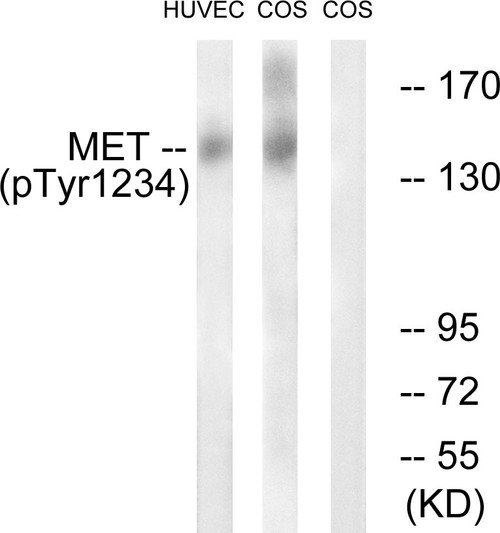| Post Translational Modifications | Autophosphorylated in response to ligand binding on Tyr-1234 and Tyr-1235 in the kinase domain leading to further phosphorylation of Tyr-1349 and Tyr-1356 in the C-terminal multifunctional docking site. Dephosphorylated by PTPRJ at Tyr-1349 and Tyr-1365. Dephosphorylated by PTPN1 and PTPN2. Ubiquitinated. Ubiquitination by CBL regulates MET endocytosis, resulting in decreasing plasma membrane receptor abundance, and in endosomal degradation and/or recycling of internalized receptors. O-mannosylation of IPT/TIG domains by TMEM260 is required for protein maturation. O-mannosylated residues are composed of single mannose glycans that are not elongated or modified. (Microbial infection) Tyrosine phosphorylation is stimulated by L.monocytogenes InlB. Tyrosine phosphorylation is maximal 10-20 minutes after treatment with InlB and disappears by 60 minutes. The phosphorylated residues were not identified. |
| Function | Receptor tyrosine kinase that transduces signals from the extracellular matrix into the cytoplasm by binding to hepatocyte growth factor/HGF ligand. Regulates many physiological processes including proliferation, scattering, morphogenesis and survival. Ligand binding at the cell surface induces autophosphorylation of MET on its intracellular domain that provides docking sites for downstream signaling molecules. Following activation by ligand, interacts with the PI3-kinase subunit PIK3R1, PLCG1, SRC, GRB2, STAT3 or the adapter GAB1. Recruitment of these downstream effectors by MET leads to the activation of several signaling cascades including the RAS-ERK, PI3 kinase-AKT, or PLCgamma-PKC. The RAS-ERK activation is associated with the morphogenetic effects while PI3K/AKT coordinates prosurvival effects. During embryonic development, MET signaling plays a role in gastrulation, development and migration of neuronal precursors, angiogenesis and kidney formation. During skeletal muscle development, it is crucial for the migration of muscle progenitor cells and for the proliferation of secondary myoblasts. In adults, participates in wound healing as well as organ regeneration and tissue remodeling. Promotes also differentiation and proliferation of hematopoietic cells. May regulate cortical bone osteogenesis. (Microbial infection) Acts as a receptor for Listeria monocytogenes internalin InlB, mediating entry of the pathogen into cells. |
| Protein Name | Hepatocyte Growth Factor ReceptorHgf ReceptorHgf/Sf ReceptorProto-Oncogene C-MetScatter Factor ReceptorSf ReceptorTyrosine-Protein Kinase Met |
| Database Links | Reactome: R-HSA-1257604Reactome: R-HSA-2219530Reactome: R-HSA-416550Reactome: R-HSA-5673001Reactome: R-HSA-6806942Reactome: R-HSA-6807004Reactome: R-HSA-6811558Reactome: R-HSA-8851805Reactome: R-HSA-8851907Reactome: R-HSA-8865999Reactome: R-HSA-8874081Reactome: R-HSA-8875360Reactome: R-HSA-8875513Reactome: R-HSA-8875555Reactome: R-HSA-8875656Reactome: R-HSA-8875791Reactome: R-HSA-9022699Reactome: R-HSA-9734091Reactome: R-HSA-9825892 |
| Cellular Localisation | MembraneSingle-Pass Type I Membrane ProteinIsoform 3: Secreted |
| Alternative Antibody Names | Anti-Hepatocyte Growth Factor Receptor antibodyAnti-Hgf Receptor antibodyAnti-Hgf/Sf Receptor antibodyAnti-Proto-Oncogene C-Met antibodyAnti-Scatter Factor Receptor antibodyAnti-Sf Receptor antibodyAnti-Tyrosine-Protein Kinase Met antibodyAnti-MET antibody |
Information sourced from Uniprot.org










